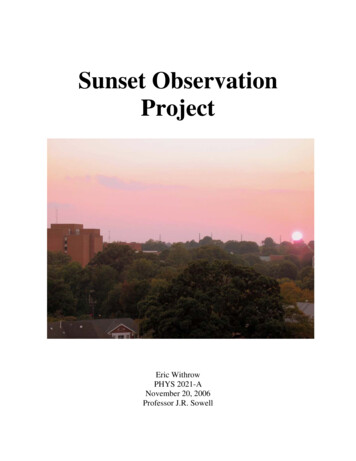
Transcription
Sunset ObservationProjectEric WithrowPHYS 2021-ANovember 20, 2006Professor J.R. Sowell
Withrow 2Purpose:The objective of this experiment was to observe the motions and position of theSun throughout its seasonal motion. During the course of the semester, numerousobservations were taken during sunset in order to determine where the Sun sets on thehorizon as the seasons progressed from summer into fall. By recording this data, it wasnot only possible to see the differing positions of sunset, but also the rate of change in theSun’s azimuth, change of sunset time, and how the position of the Sun influenced factorssuch as weather and temperature.Background:The yearly trek of the Sun on the celestial sphere is what causes the temperatureand seasonal changes we are all familiar with. The reason for this varying path of theSun involves several factors. The Sun rises in the east and sets in the west due to theEarth’s rotation about its axis. However, the positions of sunrise and sunset change dayby day because the Earth is tilted 23.5 with respect to the ecliptic, or the orbital plane onwhich the Earth sweeps around the sun. Because of the revolution of the Earth aroundthe Sun, specific terrestrial locations will receive varying amounts of sunlight dependingon the position of Earth in its orbit. In June, the Sun is directly overhead the Tropic ofCancer. This causes summer in the northern hemisphere because the effective heating isgreater, causing warmer temperatures. The opposite is true in December, when the Earthhas traveled halfway through its yearly orbit. Here the Sun will be directly overhead theTropic of Capricorn in the southern hemisphere. This is illustrated in the followingsimulation of solar lighting at both summer and winter solstices: [1]
Withrow 3When one is observing from a fixed location on Earth, in this case Atlanta, theperson will see that the Sun’s position changes from day to day as the Earth revolves inits orbit. As the seasons change from summer to winter in the northern hemisphere, theazimuth of the Sun when measured at sunset slowly progresses towards the south, asshown in this diagram: [2]Before this experiment began, I predicted that my observations would empiricallymodel this behavior. As the seasons progress from summer to fall, the Sun should set at aprogressively southern azimuth.
Withrow 4Observation Location:The location I picked to perform all of my observations was the northwest cornerof the top level of the Georgia Tech Hotel parking deck. This site provides an excellentview of the western horizon that is relatively free of obstructions. According to GoogleEarth, which displays satellite imagery of the observation location, the geographiccoordinates of the observation location are 33 46' 32.88" N latitude and 84 23' 23.57"W longitude.[3] The elevation of the 6-floor parking deck is approximately 313 metersabove sea level (taking into account the 25 meter tall parking structure) as reported byGoogle Earth. Here is a satellite image of the location from which my data was collected.
Withrow 5Determining the Sun’s Position:The instructions for this project suggest using one’s wrist to determine theposition of the Sun with respect to some fixed object. However, my opinion is that thismethod would not be accurate enough for real scientific measurements as wrist sizediffers from person to person. Also, it is nearly impossible to hold the wrist in the sameposition as the previous observations. For these reasons I decided to take a different, andhopefully more accurate, approach. By knowing about a specific camera’s optics, it ispossible to calculate the field of view seen through an image produced by that camera.The equation for determining total field of view is given by:Where d is sensor size and f is the focal length of the lens.[4] According to thespecification of the camera used for observation, a Canon A80, the CCD sensor’shorizontal length is 7.2 mm and has a focal length of 7.8 mm when set fully toward thewide angle.[5] This produces images which have a 49.55 field of view. Since the cameraproduces photos that are 2272 pixels wide, it is easy to calculate that each degreecorresponds to 45.85 pixels in the image file. It is a simple operation to measure thenumber of pixels the Sun has changed relative to a fixed point and calculate thecorresponding change in angle. I chose to use the antenna on top of the Crosland Towerof the Georgia Tech Library for my fixed reference point. For consistency I alwaysmeasured the distance in pixels from the center of the antenna to the center of the Sun.
Withrow 6Observational Data:For each observation I recorded the following data: The date and time. All time values recorded are Eastern Standard Time(GMT -0500). This allows for the negation of the Daylight Saving Time changewhich occurred on October 29, 2006. The visibility due to weather (partly cloudy, clear, etc ). The temperature and official sunset time, which was found using weather.comimmediately after the observation.[6] Pictures used to determine the Sun’s position relative to the fixed reference point.The position was calculated using the pixel distance from the Crosland Towerantenna to the center of the Sun.After the position of the Sun was determined with raw image data using the techniquedescribed above, a panorama was constructed by combining multiple images using multiband blending and gain compensation.[7] The images displayed in this report are achronological series of those panoramas.
Withrow 7Observational Data:(All observations taken from the Georgia Tech Hotel parking deck.)Obs. -10-202006-10-292006-11-09Obs. Time 0012341148105590583073061855340025122Sun Pos. ( .75.50.5WeatherPartly CloudyMostly ClearCloudy HorizonCloudyMostly ClearClearClearClearClouds on HorizonHazyPartly CloudyClearClearClearClearTemp ( F)778177837876747164797358546567Position of Sun with respect to Fixed Reference egrees North of Fixed Ref. Point35.0Date of ObservationRelative Position of the Sun ( )Linear Trendline R2 0.9987
Withrow 8Photographs:Æ To see the animation, visit http://tinyurl.com/yn463b Å
Withrow 9
Withrow 10
Withrow 11Conclusions:1. Which way was the Sun moving along the horizon? Was its motion uniform or did therate of motion change with time? Explain.My data ended up supporting my hypothesis that the Sun would progressively setfurther to the south as the semester progressed. Between my first and last observationsthe Sun moved a total of 32.7 south, which is an average of 2.35 per day. My methodof using the camera optics to measure the change in position turned out to be amazinglyaccurate. According to an online Sun position calculator, the observed total motion fromfirst observation to last observation was only off by 1.5 compared to accepted values.[8]Using Excel to plot a linear curve fit, an R2 value of 0.9987 was obtained. Thisseems to indicate the rate of change in azimuth is linear. However, I do not believe thiswould be correct if observations were taken through the course of a whole year. Sincethe Earth moves around the Sun in a near circular orbit, the position of the Sun shouldchange cyclically and have a sinusoidal shape when plotting position with respect to time.The lack of a sinusoidal graph can be easily explained because observations were onlytaken over a three month period centered around the autumnal equinox, where the sinecurve is most linear.Several derivations from linearity from one observation to another in the graphcan be explained because some observations were taken as much as 15 minutes before theofficial sunset time, due to cloud cover on the horizon. Clouds definitely were acomplication in the early phases of this project. Because of their limited height, at a largedistance some clouds and haze were inevitably blocking the Sun at the horizon unless itwas an exceptionally clear day. These effects can be seen in both the sunset time and Sunposition graphs around early September.
Withrow 122. From your observations what can you say about (a) where the Sun rises or sets and (b)the length of the day?Using my observations and some trigonometry, it is possible to determine theexact azimuth of sunset at the observation point. First, Google Earth can be used to findthe longitude and latitude of both locations. Then a right triangle can be constructed withthe hypotenuse going from my observation location to the Crosland Tower antenna.Assuming that the parking deck was constructed to be exactly perpendicular to the eastwest meridian, the angle of the right triangle will give the azimuth of the Crosland towerwith respect to due west (270 ). After correcting for the Earth’s spherical shape, Icomputed this angle to be 19.9 . This means the azimuth of the Crosland Tower is250.1 from my position. To find the azimuth of the Sun on any particular observation,simply add the observed relative angle to the azimuth of the Crosland tower. Forexample, the first sunset was at 250.1 33.2 283.3 azimuth. I observed the Sunmoving from north to south over the course of the experiment, so the azimuth of sunsetdecreased from day to day. Of course, in the spring the Sun will be moving in theopposite direction, so it would be most beneficial to take observations for a year and thenextrapolate those data points to future years.
Withrow 13The following graph gives some insight into the length of the day. Clearly sunsetwas occurring earlier in the day as the semester advanced. The average rate of changeseemed to be about one minute per day. The same change was also occurring at sunrise,although sunrise times progressively advanced to later in the day. This caused the lengthof daylight to be about two minutes shorter each day, or one hour shorter each month.This makes sense from theory, since during winter the Sun has a more inclined arc acrossthe sky with respect to the meridian. This arc would be shorter than if the Sun weredirectly overhead. Note that in the graph, the time of observation was more significantlyaffected by the position of clouds and buildings, rather than the small change of sunsettime from day to day.Official Sunset Times & Observation Times17:1517:4518:0018:1518:3018:4519:00Date of ObservationObservation Time (EST)Official Sunset Time 5-Sep8Sep1Sep19:1525-AugTime (GMT -0500)17:30
Withrow 143. From your observations, what can you infer about the position of the Sun at noonduring the semester?Since the Sun was both rising and setting further to the south each day, it can beinferred that the position of the Sun at noon is progressively further south with respect tothe zenith. This agrees with the increasingly tilted arc the Sun makes in the sky as shownin the figure on page 3. The temperature data I collected also agrees with this prediction.Since a progressively southern-positioned Sun at noon would be lower in altitude onaverage, temperatures would tend to decrease, which was observed.4. How does the altitude of the Sun affect the seasons? Was this effect evident during thesemester (e.g., temperature, weather, etc.)?Because the Sun was positioned progressively further south from day to day, thisalso meant that the Sun was lower in altitude as the semester progressed. Because theSun was increasingly low in the sky, this would cause the effective heating from theSun’s radiant energy to decrease and it would become cooler over the course of thesemester. Immediately after each of my observations, I recorded the temperature andplotted these data points with respect to the date. From the following graph, it is clearthat the temperature does in fact have a decreasing trend. It is worth noting that thetemperature did not always decrease on progressively later observations. This would bedue to the fact that temperature also depends on other weather factors such as cold frontsand heat waves, which cannot accurately be predicted long in advance.
Withrow 15Temperature vs. Observation Date85Temperature ( ep22-Sep15-Sep8Sep1Sep25-Aug50Date of ObservationTemperature ( F)Linear TrendlineI also recorded the weather during each of my observations, although this endedup being my subjective opinion on how the cloud cover should be categorized. Forobvious reasons, I never made an effort to take a Sun observation on a day when it wasraining. However, I did notice some seasonal trends with regard to cloud cover thatcould have been due to the position of the Sun. It seemed to me that there was morecloud cover earlier in the semester and that there were more clear skies in the later stagesof the experiment. My theory on this phenomenon is that early in the semester the higherSun caused more evaporation in the Gulf Coast due to greater effective heating which ledto more cloud cover. Overall, the cloud cover did not inhibit my ability to takeobservations too much. I found that sometimes it actually increased the accuracy of mypixel measurements in images because sparse clouds help to dampen the camera lensflare effect which is caused on exceptionally clear days.
Withrow 165. What surprised or impressed you the most as you performed this observationalproject?When I started this project, I was not even sure how early I would need to be atthe observation location in order to record my data. This led to some long waiting timesand some rushing to get to the observation location before sunset. Later in the semester, Icould predict to the minute at which time I would need to arrive. I was very surprised athow far the Sun moved over the course of a semester. I never realized that in three shortmonths the Sun could cover an area as big as 18% of the western horizon. I was alsosurprised at how accurate I became when trying to predict if a particular evening wouldbe good for a sunset observation. The view from outside my room faces in the oppositedirection of sunset, and even then the view of the sky is mostly blocked by large trees.However, just by looking at the light reflection gradient off the leaves, I could tellwhether the western horizon had a thick, thin, or nonexistent layer of clouds. I alsoenjoyed the view of the Moon against the sunlit midtown backdrop during some of myobservations, as shown in my last photograph. All in all, I found this to be a veryenlightening and educational experiment.
Withrow 17References1. Tom Ruen, Full Sky e:Seasonearth.png2. Hong Kong Observatory, Paths of the Sun throughout the Year ath e.htm3. Google, Sanborn, Europa Technologies. Google Earth.http://earth.google.com/4. Wikipedia. Angle of View.http://en.wikipedia.org/wiki/Angle of view5. Photo.net. Canon Powershot A80 Digital Camera Review.http://www.photo.net/equipment/canon/a80/6. Weather.com. Local Weather Forecast for Atlanta, GA ?lswe 303327. AutoStitch. A new dimension in automatic image stitching.http://www.cs.ubc.ca/ mbrown/autostitch/autostitch.html8. NOAA Surface Radiation Research Branch. Solar Position rise/azel.html
The yearly trek of the Sun on the celestial sphere is what causes the temperature and seasonal changes we are all familiar with. The reason for this varying path of the Sun involves several factors. The Sun rises in the east and sets in the west due to the Earth’s rotation about its axis










